#river forest il
Explore tagged Tumblr posts
Text

$1.985m is pretty cheap for an iconic home like the 1894 Winslow House, Frank Lloyd Wright's first commission as an independent architect. Located in River Forest, IL, the 5bd, 3.5ba, 5,000 sq ft home already has a pending sale after only 17 days on the market. And, the current owners recently did over $1m in renovations- so it's really a bargain, if you're rich. Let us peasants take a look inside.

How about your own tunnel? Actually, it's a porte cochere, and look at the platform so you can enter and exit the vehicle comfortably.

Lovely carved oak front door.


This is so different, and a little more elegant, than Wright's later designs. Would this be considered an Inglenook?

The living room looks very formal and tailored. Look at the large built-in seat by the window. I like how they did the walls.

The windows are lovely leaded glass. If you were short of funds after buying the house, you wouldn't have to worry about buying seating for awhile, at least.

The library. Wow, there are so many built-ins in this home.

Isn't this a gorgeous entrance to the dining room? I have to say, this may be my favorite Wright house.

Nice ceiling, more built-in seating, and look at the columns. Very unlike Wright's usual style.

He really went bonkers with the built-in seating.

This is an enclosed sun porch. You can see the outer brick walls of the house.

I guess they redid the kitchen, and I can't decide how original it is. The only thing that would be original are the high upper cabinets, but I don't know about anything else.

It has quite a large pantry that's very pretty.

Nice everyday dining area.

Guest half bath has a vintage sink and new toilet.

The stair railings remind me of a harp.

The bedrooms are plain. They have nice moldings, though.

They renovated the baths.

Most older homes don't have walk-in closets like this.

Maybe this is the primary bedroom.

Original fireplace in the family room up here.

Finished attic is more of an office area, but it could be anything, really. I like the nook that the desk is in.

Lovely grounds.

Two patios.

The garage has a separate residence.


Could be a guest apt. or rental.

It has a cute outdoor area, too.

Look at the path around the garden. The lot is .67 acre.
https://www.redfin.com/IL/River-Forest/515-Auvergne-Pl-60305/home/13325458
216 notes
·
View notes
Text
poor provincial town — il capitano
summary. your father disappears suddenly, so you set off in search, and discover something much worse than the monsters you were warned about in your quiet little village.
notes. nvuy actually writing something holy shit we lost. it’s a beauty and the beast spin off. i want this man so badly i will trudge across the sahara desert just to lick off his sweat to cure my unbridled thirst.
warnings. 16+, mature themes, you can interpret capitano as yandere but he’s also implied to not be human (riding on the draconic capitano headcanons here) so in general he’s just a weirdo, he’s probably ooc because yeah, gn reader (any usage of the word ‘man’ is just another word for ‘human���), mentions of violence, threatening, violent threats can also be interpreted as sexy i guess, mentions of death, AU sort of because beauty and the beast spin off.

Your father had gone missing.
The news had shaken you to your core, and despite the wrangling on from the poor terrible and boring provincial town that you hailed from, you planned to set out almost immediately in search of him.
The people had warned you of wolves in the forest, flesh eating bugs that crawled in the winter snow, and men with pointy sharp teeth and large claws that could slice you to ribbons. All horror stories from children’s books; the same nightmares you had when you were little. Raging beasts within the trees to make sense of the shadows that moved strangely in the night.
You were warned, denied, almost locked away in your home for protection. But, you moved. You set out, for your father was already old and frail as he was. You couldn’t imagine him being lost to the woods. Not your father. He was wiser than to step out by himself, and especially so deep within the trees.
“It does not make sense for you to venture by yourself. Trekking through the woods is not for people such as you.” The older lady of the town library told you one day. “What lies out there… I could not tell you.”
You took the book from her hands and pressed your fingers into the hard cover. Your nails left a permanent dint in the laminate. “I do not fear death.”
“Not death,” she corrected. “Death is not what lingers.” She then glanced up at the ceiling, thoughtful. “Death is beautiful. What you should be afraid of are people.” She looked back down at you before a sad grin grew onto her lips. “Speak not to strangers, for you may provide dinner for the beasts that roam the woods.”
She did say beasts, you know. Monsters with fangs and fur and hooves that knew nothing but to bite and eat, eat, eat.
But there are various sorts of beasts. Charming, handsome quiet beasts. Kind and polite and patient.
“It is the gentle beasts that are the most dangerous of all.” The older lady sighed deeply, perturbed. She fidgeted in her seat behind the counter. “If you do leave, bring a weapon.”
You cannot fight, though you did pocket a small dagger.
And then you set off. Through the woods, down hills, across rivers, trying to piece together a narrative as to why your father had disappeared. It was winter — though, it did always snow here — and the winds were much more biting than usual. Thankfully, you had brought layers, and the thick hood that wrapped over your head did its job in banishing most of the cold.
It did not stop the lingering gazes of the creatures that crept along the trees, and lingered within the shadows.
You are soaked in snow and wind and cold, but you press on.
You eventually stumbled upon a castle. A grand one, with cracked and broken windows, thorny leafless bushes that surround the forked fencing, and a door so giant your hand can barely wrap around the handle. It is the only source of shelter for miles.
He must be here. Your father was ill. He needed a roof to sleep under. And possibly, despite its state, the castle could have food hidden away if looked for thoroughly.
You push open the doors, wincing from the loud creaking that alerts your presence to anyone residing inside. It looks abandoned. The once polished floors and mangled and ruined, and it a single candle flickers with life. The chandelier sits on the floor, smashed to pieces, and glass spills from every corner.
It is dark, and cold, but it is shelter.
So, you search.
High and low, wandering through the endless halls, trying to trace your steps. You search upstairs first. There are many levels, perhaps maybe five or six, and as you look, you find different rooms. Grand empty ballrooms, bathrooms that once had plated gold edging to every corner and crevice, bedrooms with torn sheets and broken wardrobes. Most rooms were empty — you cannot imagine being able to fill every single one.
Then, you search downstairs. You hadn’t wanted to go below the ground, but your father did not answer to any hushed whisper you called, and you were beginning to lose hope.
The deeper you go, the more you feel trapped.
There are cellars down here, and they stretch on beyond what your eye can see.
The cellars are dark and twisted and cold. It smells of mildew and mould, and every step you take emits a splash from the puddles. The walls are brick and cracked and covered in moss so old it has turned black with time. There are no little white flowers along the vines.
You step further along the wet stone, feeling along the wall blindly. Your nails scrape along, and you try to even your breathing. It’s cold. It’s cold. Frost and snow still clings to your clothes.
That’s when you spot your father rotting away in a cell, and you quickly take his hands through the bars. He’s frail and older now, and so much sicker from being locked away for so long.
You cry out pathetically when he struggles to curl his fingers around yours. Frostbite has taken the tips, and his skin has morphed to an ugly purple and black.
“You shouldn’t have looked for me,” he tells you. Then, he glances down the dark hall. He cannot see anything, for shadows linger across the walls like spiders crawling upon silvery silken webbing, but he knows there is something out there. “You shouldn’t have come here.”
You dismiss his concern. “You’re freezing.” You squeeze your hands tight over his thin skin before you shed off your hood and hand it to him through the bars. “Who did this to you?”
“You need to leave,” your father pleads.
“‘Leave?’” you echo. You try to see through what little light there is for a keyhole. You do not have a key, but the iron is rusted and weak, and you’re sure you can find something to smash the door through with. “I cannot leave. Not without you.”
You search around. You try to steady your racing heart, breathing deeply through your nose. Fog passes from your lips with each breath. Water drips from somewhere, and the constant ticking and creaking of the old bricks make you nervous.
You’re concerned the entire floor will collapse, so you work quick.
The cellars are empty and abandoned. Most of the doors are open, and there’s no keys in sight. There are no weapons, either, nor any long poles to smash the door down.
You panic.
It’s hopeless.
This place is completely empty.
You turn back to your father and try weakly pulling at the door. It does not budge. “Who locked you in here?”
“A beast,” he replies. It is said in a whisper, as if he’s afraid of even uttering the word. “It tore me off my path and brought me here.”
But beasts can’t be real. They’re just fairytales; stories your mother told you when you were little so you wouldn’t wander off by yourself. “Did it hurt you?”
“No. Not yet.” He glances down the hall again. “But it may hurt you.”
“I am not leaving without you. I have searched for days.” You stand up to search for something again, but you know deep down it is futile.
There is nothing.
There’s nothing here.
You want to weep, but that will not help.
It’s hopeless. It’s all so twisted and horrific. There is no beast here. There cannot be. You would have stumbled upon it by now. It would have sliced you to ribbons by now. It would have locked you away with your father by now.
“Listen to me,” your father whispers. “Return to the village and call for the soldiers.”
You shake your head.
“They will not listen to me. They think I’m crazy.” And they do. You briskly wipe at your tears and kneel down in front of the bars again. Then, helplessly you bash at the bars, and the sound echoes down the halls. “How do I get you out?”
Your father tries to quiet your sobbing. “Go back to the village. Find General Zasha, speak with the soldiers.” He grabs your hands through the bars. “The General will listen to you.”
“He will not.”
“He will.” Your father nods once, confident. “I know a man in love when I see it.” Your father kisses your knuckles once before he lets go. “I will be alright.”
He will not be, but you stumble to your feet and back away from the cellars.
And then you leave. You say not a parting word to your father. You pray and hope he remains alive for another few days. You can do nothing else but trek back up the stairs and return to the main halls.
You know they must have been beautiful once. Now everything is old and withered and etched away.
In another world, another life, just maybe, you would have loved to roam the halls of a castle and spoiled endlessly.
You walk slowly, beaten down, cold and alone. Your bones ache with exhaustion, but you will not rest here. You are determined to return to the village and speak to the general, even if you despise him with every inch of your heart.
Your hand reaches for the door handle.
“What’s this?”
And then there is a blade at your throat.
“Another thief roaming my halls?”
You swallow, but all that does is press the blade further into your skin. The discomfort sends you into a panic, and your breathing stutters. Your hand remains wrapped around the handle, but you cannot will yourself to move.
Escape is futile.
You should not have come here.
The blade is removed swiftly. So swiftly that the sharp end glides along your throat and leaves a shallow cut. It stings, and you try not to cry out in fear. Sweat pools down your neck and twists into the new cut. You hiss silently at the pain.
“What did you steal?”
You do not turn around. “Nothing. I am no thief.”
“Then you know the man I locked away.” His voice is deep, and it echoes in the hall. “Otherwise, you would never have come at all.”
You turn slowly, aware he is still armed.
It is a sword he holds, though it is hidden away beneath a large feathered and fur coat that rests upon his shoulders. Long black hair falls from beneath a mask that covers his face, and the shadows below disguise his skin, and anything that can identify him.
He is taller than you. Much taller, and much bigger. You cannot fight him.
“Why did you lock away my father?”
“Your father is a thief,” he replies easily. “And thieves remain thieves until they rot.”
There is no noise. It is just you, and him, and the constant dripping of water from your hair.
“My father is not a thief, beast,” you argue. “You are locking away a sick man.”
“I am no beast,” he denies. “I am man.”
“A man with a blade is no different to a beast.” He must be a beast. There is no reason as to why he would reside in a place such as this. “I will bring back an army.”
“Oh, yes, I’m sure you will.” It sounds condescending, and you scrunch your face up when he leans down to scrutinise you. “That is if you can leave my grounds alive.”
“You will die before you lay a hand on me.”
You pull out the dagger residing in your pocket. It is a desperate attempt to create space between you, but the knife only manages to garner a simple tilt of his head.
It’s small, barely deadly, but if angled right, you could take out an eye. But the thought of that makes you crumble; you don’t fight.
The man simply tuts. “You are not even worth a chance to spar.” He simply plucks the weapon from your hands. “How you survived out there is both a mystery and a miracle.”
“I am not weak,” you say. You don’t feel it’s true.
“Stubborn. You are stubborn.”
Your finger twitches in frustration. “Free my father from his cell.”
“Bring your army,” he answers. “It has been a while since I’ve been faced with a challenge.”
“You will lose your head before you even unsheathe your weapon.” You’re not sure if it’s true, but you have to trust yourself. Just this once. “You cannot take on one hundred men.”
“I have once. I will do it again.”
“I will be honoured to have your severed head hanging as decoration in my bedroom,” you sneer. “You will not win this. Your arrogance will be your downfall.” You try to twist and make for the door again, but he holds steady on your wrist. “Unhand me.”
The man, or the beast, or whatever he is, does not falter.
“You are small. Whatever army you bring will be smaller.” He pulls once at your wrist and that silences your struggling. It hurts and stings in warning. “Puny. Is this the best you can do? What if you were to run into a real beast?”
“Let go of me!” you try.
His grip tightens. You fear your bones will snap into pieces. You’re unsure if the skin beneath his gloves belongs to a man or a beast. The tips are sharpened and metallic, and you’re sure they can pierce into your flesh.
He leans in close. Too close.
Close enough you can barely identify the outline of lips drowned out by the shadows that swamp his features. A big man, much too big for you, and he terrifies you beyond your nightmares.
You will dream of him.
Terribly.
“Let go of me,” you plead quietly.
“Let us strike a deal,” he whispers.
“I will make no deals with any man,” you defy.
You see a smile and a flash of sharp teeth.
“I am no man, nor beast,” he responds. “Send your men. Send one thousand. Send every man that has ever walked this plain.” He grabs you even tighter, and if the mask did not obstruct his face, your lips would have touched his, and the scar that runs across the vermillion. You share his breath, and you smell blood and ash. “I will kill them all.”
You feel he tells the truth.
Still, you insist. “You will die.”
“If I do so perish, then the wager is in your favour. Have whatever you wish from this place. Destroy it, restore it, it is yours.”
You want to tell him you do not want this terrible castle. You want your father home, but you are aware he knows this. You open your mouth to speak, but a hand abandons one of your wrists to grab your face and squeeze just enough to keep you quiet.
His claws press into your flesh. You try to wretch yourself free and rake your nails down his arm.
“And if I kill every man you send, I will return your father.”
Your eyebrows furrow in confusion.
“I will have you instead.” He twists you further towards him, and your lips touch. “I will decorate these halls with the heads of every man of your village, and I will ruin you.”
That is a promise. You know it is. You can tell from how he whispers it, and how his grip has slackened into something more gentle than it was before.
“You cannot–” Nothing comes forth from your lips.
“I can.” He lets go of your other wrist and twists his claws into your hair. “It has been so long since I have tasted the flesh on mortal bone.”
The man, whatever he is, releases you finally, and you startle backwards against the door. Blindly, you feel for the handle behind you, trying to keep your breathing even as you finally grip onto the cold metal.
The door swings open behind you and you step outside of the castle. The cold hits you instantly, and you double over in the icy strong winds. You abandoned your hood to your father, and have nothing to shield your eyes. They sting with tears and snow.
Something drapes over your shoulders, heavy and warm.
It’s a coat. The same feathered and furred coat, though it is not laid onto you out of concern or politeness. It is possession, and complete control, ownership when the beast grasps your chin from behind you one last time.
You stare out in fear into the forest ahead.
“Flee, little one.” You feel his lips on your ear. “Time slips away as the clock ticks forward. The world will stop for you, if I so choose it to wait.”
He is warm. Warm against your back, and it provides temporary, ill-fitting relief into your skin.
“I await your return, blade honed, and hungering for your skin.”
You slip from his grasp. “If I don’t return?”
“Your father will draw his final breaths in my cellar,” he tells you, “and once he does, I will chase you to the ends of the earth to deliver the good news.”
#✦ ( the macrocosmos. )#il capitano x reader#capitano x reader#the captain x reader#genshin impact x reader
331 notes
·
View notes
Text


A recent trip to Red River Gorge has supposedly led to some interesting findings, or rather a potential accident of some kind. I posted this lichen image on I naturalist to see what it was as I was very unfamiliar with anything that could compete or mat this aggressively to the point that even moss was having a hard time establishing past it. My friend Shaun managed to correct my attempt at Identification and he seems pretty sure about the ID all though im waiting on two others to comment on it as Ide prefer curators in something like this.
Due to recent storm damage and downed trees it has now become an optimum time to look at dry bark before rot starts phasing in and humidity invites more fungus and moss not associated high light exposure and upper canopy of trees in the gorge, it also luckily has caused unofficial trail hikers to learn to meander or create new trails via bushwack and elephant path(desirepaths) in order to relocate the original unofficial trails since trail maintenance only exsists for those that are declared official trails. During one such meander I accidentally walked past this lichen for the first time in my life.
Micareopsis irriguata
Sandstone Sea fog/foam lichen.
A species only mentioned in the Keys that I have but has no photos available due to it's scarcity, it has 1 report in Kentucky besides this current one in Red River Gorge and has plenty of potential to be found in many locations where sandstone ravines are found (WV, KY, TN, IL, IN, OH, PN, AL.) Yet reports are minimal and records are scarce in herbariums. Right now for example I nat has less than 20 reports on the species as a total.
Surrounded by some moss, Cystocoleus ebeneus (black hair lichen); There are actually other lichens in this shot too that are not easily identifiable and what may be Leptogium spp. of some kind and or Scytinium spp. or perhaps some mealybug like look alike maybe even a pin lichen. Found on a humid exposed sandstone cliffs near the base of cliff face, Bison Way downsend trail near the upsend roots to Adena Arch shortcut.
Sea foams and rain forest lichens are very similar and are common names for a group of species associated with a bullate(thick bumpy, often with convex tile-like areoles) thallus that is somewhat reminiscent of foamy surfaces. These aren't necessarily uncommon nor rare in rocky areas but some are definitely less present due to inland association or coastal association and microclimates. This was more of a happy accident to me, I was curious about it, hadnt noticed it in the area before, didn't know what it was at all, so I took a picture to look it up as it was way more dense than a powder lichen (like Lepraria finkii or Botryoleparia lesdainii and had apothecia instead of what I associate with almost ascoma like reproductive structures that are often seen on things like the mucose thalloid mats of Multiclavula mucida and thicker crustose hard algal like thalloid mats like those associated with Dibaeis spp, or perhaps Bacidinia delicata and Baeomyces rufus. Similarly it is notable that im not the only one who associates these species at all because we can juxtapose the name sake of Micareopsis spp., which could of used oides as well to mean "looks like", to Micarea spp.
Micarea spp. or "the lumpydumps" are often mucus like thallus that form thalloid mats on rotting wood and can appear to look like Multiclavula mucida at first glance or similarly Ive looked at Arthonia ruana pictures online which is also an algal film species. So when I speak I mainly am refering to the conifer wood species Micarea (prasina, micrococca, and maleana) respectively. Each associated with wood substrate only( again specifically conifers that are in various stages of decay in humid microclimates) unlike the sandstone dwelling Micareopsis irriguata.
38 notes
·
View notes
Text
View from the Blackforestline suspension bridge
Canon EOS R
Sigma 24-105mm F4 DG OS HSM | Art
ƒ/9.0
24.0 mm
1/125
iso 160

Blackforestline suspension bridge
(FR) Pont suspendu dans la Forêt-Noire Le Black Forest Line Pont Suspendu est un pont situé dans la Forêt-Noire, en Allemagne, à proximité du village de Todtnauberg. Il mesure 450 mètres de long et domine le sol de 120 mètres.
Caractéristiques
Longueur : 450 mètres Hauteur : 120 mètres Coût : 5 millions d’euros Ouverture : fin mai 2023 Capacité : 300 personnes simultanées
Emplacement Le pont est situé dans la Forêt-Noire, à proximité du village de Todtnauberg, à environ 1h30 de route de Strasbourg.
Contexte Le Black Forest Line Pont Suspendu est l’un des derniers ajouts à la région touristique de la Forêt-Noire. Il est conçu pour offrir une expérience unique aux visiteurs, avec un panorama spectaculaire sur la vallée et les chutes de la rivière Stübenbach.
Comparaison avec d’autres ponts suspendus Le Black Forest Line Pont Suspendu est plus long et plus haut que le Wildline Pont Suspendu, situé à Bad Wildbad, dans le nord de la Forêt-Noire. Cependant, il est plus court que le pont suspendu de Rottweil, qui est en cours de construction.
Impact local L’ouverture du pont suspendu a suscité des débats locaux quant à son impact sur l’environnement et la communauté. Certains résidents sont préoccupés par l’impact touristique et la perturbation de la vie quotidienne, tandis que d’autres voient l’opportunité de développer le tourisme durable dans la région.
En résumé, le Black Forest Line Pont Suspendu est un projet touristique majeur dans la Forêt-Noire, offrant une expérience unique et spectaculaire aux visiteurs.
(EN) Suspension Bridge in the Black Forest The Black Forest Line Suspension Bridge is a bridge located in the Black Forest, Germany, near the village of Todtnauberg. It is 450 meters long and towers 120 meters above the ground.
Features Length: 450 meters Height: 120 meters Cost: 5 million euros Opening: end of May 2023 Capacity: 300 people simultaneously
Location The bridge is located in the Black Forest, near the village of Todtnauberg, about 1.5 hours drive from Strasbourg.
Background The Black Forest Line Suspension Bridge is one of the latest additions to the Black Forest tourist region. It is designed to offer a unique experience to visitors, with a spectacular panorama of the valley and the waterfalls of the Stübenbach River.
Comparison with other suspension bridges The Black Forest Line Suspension Bridge is longer and higher than the Wildline Suspension Bridge, located in Bad Wildbad in the northern Black Forest. However, it is shorter than the Rottweil Suspension Bridge, which is currently under construction.
Local impact The opening of the suspension bridge has sparked local debates about its impact on the environment and the community. Some residents are concerned about the tourism impact and disruption to daily life, while others see the opportunity to develop sustainable tourism in the region.
In summary, the Black Forest Line Suspension Bridge is a major tourism project in the Black Forest, offering a unique and spectacular experience for visitors.
#Allemagne#SIGMA 24-105MM F/4 DG OS HSM ART#Lieux#Road-Trip#Alsace#Germany#Canon EOS R#24-105MM F/4 DG OS HSM#flickr#outdoor#photographers on tumblr#original photographers#extérieur#black forest#Forêt-Noire#schwarzwald#Blackforestline#suspension bridge
26 notes
·
View notes
Text
Masterpost of Trip Photography Tags
Anchorage --> Deadhorse --> Denali --> Homer
Chicago --> Grand Canyon --> Denver --> Chicago
Florida (Fort Lauderdale, Key West, Everglades)
Chicago --> Badlands --> Yellowstone --> Denver --> Chicago
Vermont --> Upper Peninsula --> Superior National Forest
Chicago --> Platte River, Nebraska
Chicago --> Mammoth Cave National Park
Oslo --> Tromsø --> Svalbard --> Greenland --> Svalbard
Boston --> Quebec City --> Toronto (Pearl Jam)
Chicago --> Juneau, Alaska
Juneau --> Deadhorse --> Anchorage --> Yakutat --> Juneau
Juneau --> Chicago
Florida (Disney World)
Minneapolis --> Superior National Forest --> Minneapolis
Estonia --> Stockholm --> Copenhagen
Chicago --> Shawnee National Forest --> Cairo, IL
Chicago --> Missoula, MT --> Indianapolis --> Chicago --> Philadelphia --> Baltimore --> Boston (Pearl Jam)
Chicago --> Thombson, MB --> Churchill, MB --> Chicago
36 notes
·
View notes
Text
VERRÀ LA MORTE E BERRÀ IL TUO SANGUE
(Prima parte di una serie divulgativa sulla prossima apocalisse pandemica)
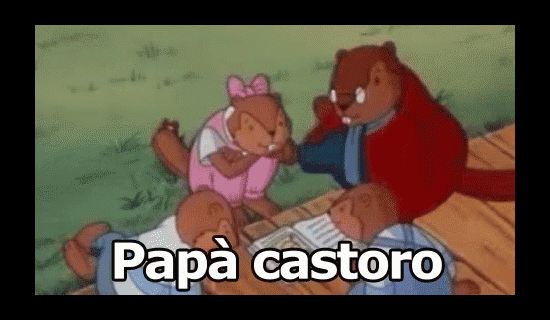
Buongiorno, bambini! Chi mi sa dire qual è l'animale più pericoloso sul pianeta terra?
Il leone! Lo squalo! L'orca sassina! La tigre! Il gorilla! Il rinoceronte! I fascisti di forza nuova!
Gigino ricordami di non lasciarti tutto il giorno con zio Stanislao, comunque, no bambini... l'animale che ha ucciso più esseri umani nei nostri secoli di storia è...
... la zanzara!
Repubblica.it dice che ha sterminato 50 miliardi di persone nei nostri 300.000 anni di storia ma siccome sarò anche vostro papà però anche un castoro senza pollice opponibile non ho possibilità di verificare le fonti in modo approfondito.
Diciamo, però, che le zanzare sono praticamente ovunque, tranne in Islanda e ai poli, e nei millenni di convivenza con l'uomo sono diventate un vettore preferenziale per molti virus che si sono mutati per replicarsi all'interno delle loro ghiandole saliv...
Anche il raffreddore?
No, Genoveffa, solo alcuni patogen...
Anche l'aids dei finocchi?
No, Balilla... e ricordami di non lasciarti tutto il giorno con zio Benito. Ecco, vi ho appena inviato sui vostri tablet la lista di virus, batteri e parassiti trasmissibili dalla famiglia delle Culicidae (che sarebbero le zanzare).
Malaria Chikungunya Filariasi Dirofilariasi Dengue Zika West Nile Virus Febbre gialla Febbre della Rift Valley Encefalite giapponese Encefalite di Saint Louis Encefalite LaCrosse Encefalite equina orientale Encefalite equina occidentale Encefalite equina venezuelana Febbre di Ross River Febbre da Barmah Forest
Naturalmente non tutte le 3540 specie di zanzara trasmettono tutte queste malattie sia perché non tutti i patogeni sono adatti a replicarsi in ogni ghiandola salivare sia perché molte malattie sono tipiche di un paese specifico con un certo tipo di zanzara che sopravvive solo con un certo clima.
A tale proposito, mi premeva farvi notare come quando io ero giovane non solo saltavo i fossi per il lungo e invece voi vi fate venire la tendinite da smartphone ma d'inverno venivano quattro metri di neve e l'estate si poteva stare a torso nudo senza morire di ustioni attiniche di 4° grado e questo è colpa de...
Delle scie chimiche massoniche dei poteri forti!
No, Giustino… e ricordami di non lasciarti tutto il giorno con zio Beppe.
È colpa del cambiamento climatico che ha portato a una tropicalizzazione di latitudini dove normalmente le zanzare tropicali vettrici di tali virus non sarebbero sopravvissute.
Siccome, a dispetto di quanto gli italiani credano, noi castori siamo una specie che fino al 1540 ha popolato per secoli lo stivale (salvo poi diventare tutti copricapi), ho le carte di cittadinanza in regola per parlare di tale paese e pubblicare questa mappa:
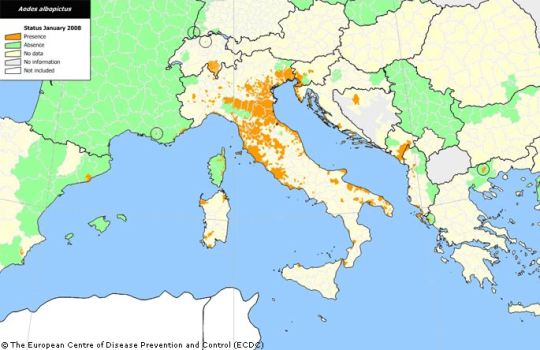
con cui nel 2008 si registrava l'iniziale presenza della zanzara Aedes albopictus, la cosiddetta Zanzara Tigre, che ha quasi completamente soppiantato la meno feroce Culex pipiens, la nostra 'vecchia' zanzara monocolore che pungeva solo di notte

(albo+pictus, pitturata di bianco... anche se a me sembrano pallini e non le presunte strisce di una tigre)
e di seguito una vecchia proiezione statistica - oggi realtà - su come si sarebbe riprodotta ed espansa
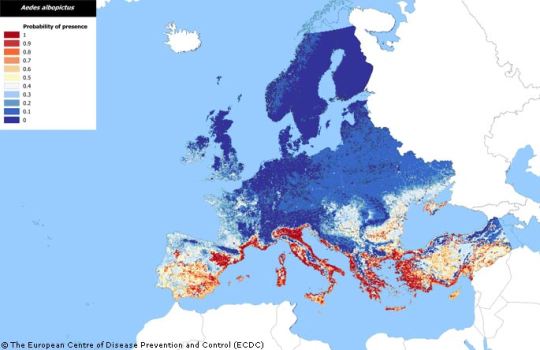
Voglio dirvi però, piccoli castorini, che le quattro malattie che puntualmente gli italiani si ritrovano a scoprirsi addosso ogni estate (Zika, Dengue, Chikungunya e Febbre da West Nile Virus) in realtà hanno modalità di incubazione e trasmissione che le rendono meno pericolose di quanto sembra, perché ci devono essere parecchi fattori concomitanti per la comparsa:
PRIMA DI TUTTO CI VUOLE UNA ZANZARA INFETTA
Graziarca' mi direte voi ma considerate che una zanzara può replicare il virus nelle proprie ghiandole salivari solo se punge una persona infetta in fase attiva, quindi non nei prima 4-7 giorni della comparsa dei sintomi e non dopo 15 giorni.
La zanzara può infettare solo dopo 7-10 giorni (tempo di replicazione nelle ghiandole) e dal momento che una zanzara ne vive solo 30, il tempo utile è poco (il virus non si trasmette da zanzara a zanzara o alle uova).
Oltretutto non è detto che la carica virale dell'umano infetto sia sufficiente alla replicazione nella zanzara o che la puntura della zanzara abbia sufficiente carica virale da infettare.
Quegli R0 e Rt esponenziali che abbiamo visto con il Covid scordateli, insomma.
Infatti, tranne l'ultimo caso di Dengue del 70enne lodigiano che è sempre rimasto in Italia, tutte le infezioni sono state contratte all'estero e 'portate' senza grosse conseguenze in Italia.
La mia è un'intuizione e quindi vale solo per fare apocalisse zombie su tumblr ma credo che se si cominciasse a fare titolazioni anticorpali tra la popolazione, sono quasi sicuro che verrebbero fuori MOLTE persone positive a vecchie infezioni causate da questi virus.
Perché i sintomi comuni a tutte queste infezioni sono spossatezza, mal di testa, dolori articolari e difficoltà alla concentrazione...
Praticamente io sono ammalato di Dengue ogni Lunedì.
Seguiranno approfondimenti su modalità di manifestazione e trattamento.
Grazie dell'attenzione e dell'eventuale gentile reblog di condivisione.
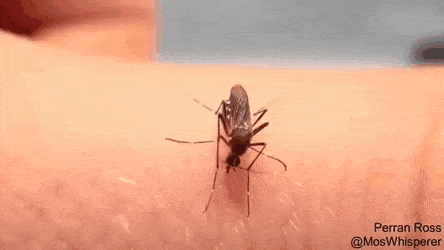
142 notes
·
View notes
Text
Pleasant Home, Oak Park IL
Pleasant Home (Farson-Mills House), 1897, 217 Home Avenue, Oak Park, IL 60302
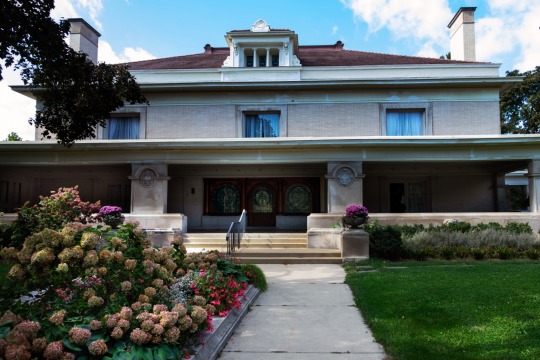
Pleasant Home
George W. Maher designed this 30-room mansion for millionaire banker John W. Farson of Oak Park. Farson purchased the lot at the corner of Pleasant St. and Home Ave. in 1892 for $20,000, the largest price ever paid for a residential lot in Oak Park. Over the following years he acquired land to the south and west for a large garden.
Herbert S. Mills, the second owner of Pleasant Home, made his fortune in the amusement business. The Mills family sold the house in 1939 to the Park District of Oak Park, the grounds being designated as Mills Park in their honor.
The home today is operated as a historic house museum, an events venue, and serves as the headquarters for The Pleasant Home Foundation.
The house is listed on the National Register of Historic Places.

Illustration of Pleasant Home from The Inland Architect and News Record
Considered one of the earliest examples of prairie school architecture, Pleasant Home is often viewed as the finest surviving example of Maher's residential work. The house was completed three years after Frank Lloyd Wright's Winslow House in River Forest, an early expression of Wright's emerging design principles, later to be known as the prairie style.
The Prairie School developed in sympathy with the ideals and design aesthetics of the Arts and Crafts movement of 19th century England by John Ruskin, William Morris, and others. It is also seen as a successor to the Chicago School of architecture associated with architects William Le Baron Jenney, H.H. Richardson, Daniel H. Burnham, John Wellborn Root, Dankmar Adler, and Louis Sullivan.
The Prairie School attempted to develop an indigenous North American style of architecture, without the design elements and aesthetic vocabulary of earlier styles of European-influenced architecture such as the Queen Anne and Gothic Revival styles.
The smooth surfaces of Roman brick, the low-pitched, hipped roof and the broad entrance porch of the Parson House are characteristic features of Maher's work that link him to the early modern designs of his Prairie School contemporaries. In the Parson House Maher also introduced his personal design philosophy, which he called motif rhythm theory, to unify the decorative details of the house and its furnishings. The house retains its historic integrity in terms of materials, design and setting. Virtually all of the original decoration specified by George Maher is preserved and the lavish decorative treatment is everywhere apparent on the interior.
Kathleen Cummings, National Historic Landmark Nomination, 1996

Detail of front porch support column
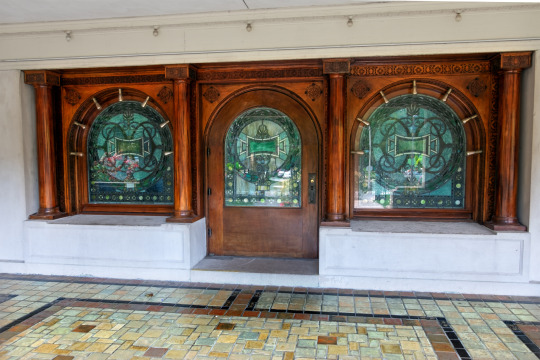
Stained glass entrance and flanking windows

Entrance hall fireplace beneath Pleasant Home panel
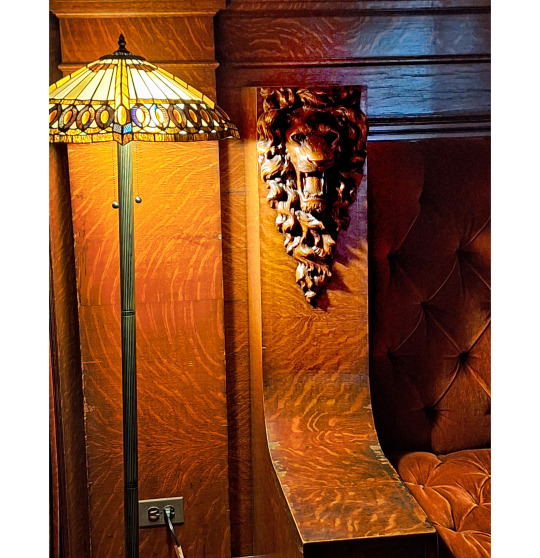
Detail of lion head carving, repeated throughout the house, on entrance hall built-in bench

Carved screen in entry hall in front of the music room on the mezzanine
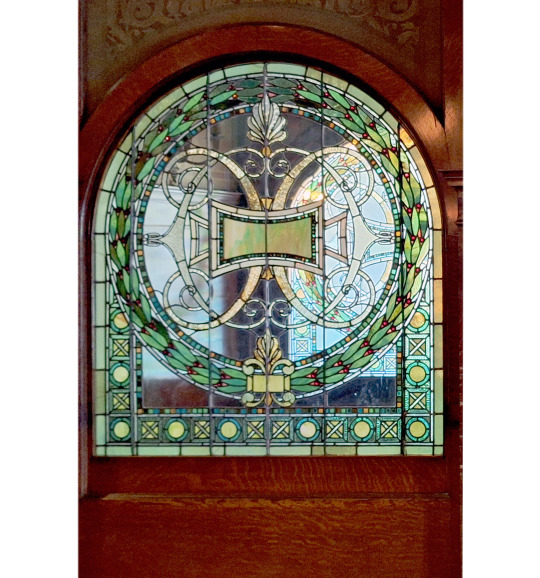
Stained glass entrance window
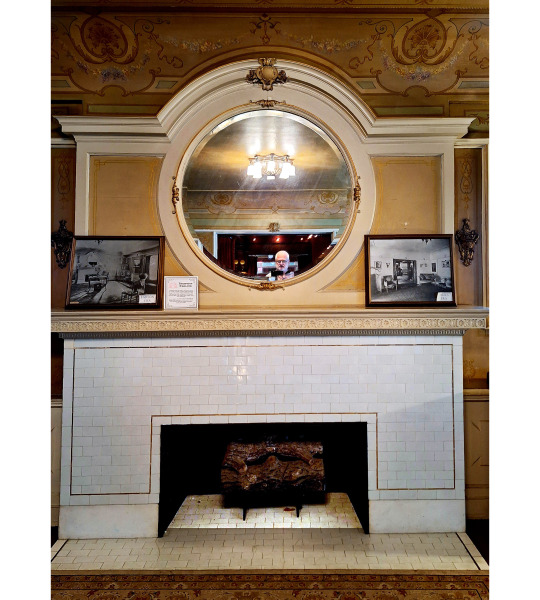
Reception room

Living room or sitting room
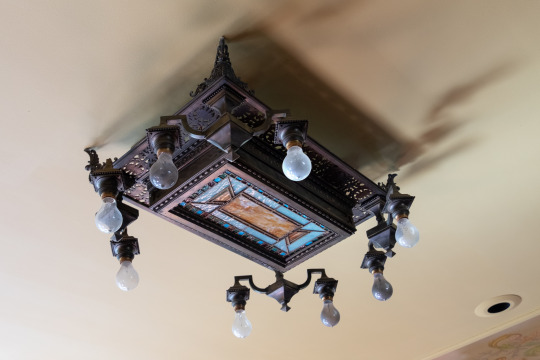
Dining room ceiling fixture

Dining room

Dining room corner, leading to summer dining room

Domed light fixture in the library

Library

Original Maher-designed dining table and chairs, now displayed on the second floor

The stunning original wall colors are seen in the above two photos of second-floor bedrooms
Vintage views of Pleasant Home, from the Ryerson and Burnham Libraries, Art Institute of Chicago:


Left: George W. Maher and John W. Farson in the garden of Pleasant Home
Right: Entrance hall
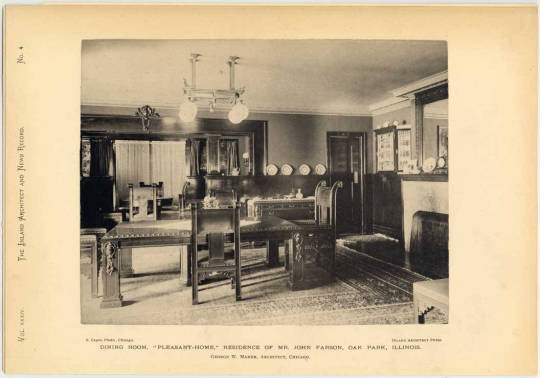
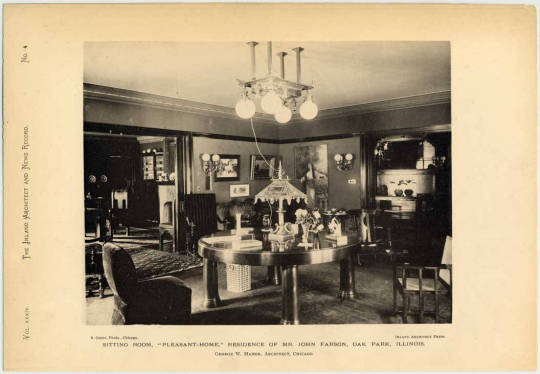
Left: dining room Right: sitting room
The Ryerson and Burnham Libraries, Art Institute of Chicago, house a copy of the 1902 publication "Farson, John, Residence; Farson-Mills Pleasant Home." The publication contains many views of the house, exterior and interior.
Collection Call Number FF Special NA7239.M34 A65 1902.
Access the digitized copy at this link:
#Farson#house#Oak Park#Illinois#Pleasant Home#George W. Maher#Maher#architecture#chicago#photography#Prairie Style#residential
9 notes
·
View notes
Text
Dam project threatens Indigenous rituals, hunting areas, and even gravesites in the Tenharim Marmelos Indigenous Land
InfoAmazonia and BdF visited the territory to understand the views of the indigenous people about the construction

Once a year, dozens of indigenous people from the Tenharim Marmelos Indigenous Land (IL), in the municipalities of Humaitá and Manicoré, Amazonas state, leave their villages on an expedition towards the southern end of their territory, where the headwaters of the Branco, Preto and Marmelos rivers are located.
The group spends up to 20 days in the forest and returns with game and fish that provide food for all participants of the Mbotawa festival, held in July. The celebration gathers the population of the eleven villages in the territory, as well as guests from other indigenous groups of the Kawahiva branch.
Up to 500 people take part in the festival to experience, together, the rites of the Tenharim – weddings; the ritual of young women, which marks young Indigenous women’s passage into adulthood; and the ritual of the dead, in which the memory of the deceased is revered.
“When we organize this party, we involve the entire territory. Women, children, young people and the elderly. It is a time for older people to pass on traditional knowledge, our culture and traditions to youth,” explains Daiane Tenharim, head of the Tenharim Morõgwitá Indigenous People Association (Apitem).
The expedition goes to the most preserved part of the territory, which the Indigenous people call “the market.” They do not hunt or fish in that area during the year, precisely to have a “stock” to which they can resort for the July festival. The area has been inhabited by the Tenharim since before they had contact with non-indigenous people. It is the site of the ancient village Aeguera, after which a stream connected to the Preto River is named.
Being an area of virgin forest, isolated indigenous groups also circulate there, recognized as Kawahiva relatives by the Tenharim. They are identified by the National Foundation of Indigenous Peoples (FUNAI) as the Kaidjuwa isolated group, but their registration has not yet been confirmed by the General Coordination of Isolated and Newly Contacted Indians (CGIIRC), a FUNAI branch. That is what effectively guarantees the measures to protect their circulation area, since confirmation suspends all economic activities as well as contact with non-Indigenous people by restricting use of the area.
It is also in that area that the construction of the Tabajara Dam is planned, a 37-square mile (97-sq. km) reservoir in Machadinho d’Oeste, Rondônia state. The project has been under discussion for 17 years and, as revealed by InfoAmazonia and Brasil de Fato, it should reach nine Indigenous lands (ILs), including isolated peoples. The Tenharim Marmelos is the closest IL to the project.
Continue reading.
#brazil#brazilian politics#politics#environmental justice#indigenous rights#image description in alt#mod nise da silveira
17 notes
·
View notes
Text
The deepest and largest natural well on the planet is called Xiaozhai Tiankeng. It is located in Fengjie, Chonqinun Municipality, in the heart of China. This amazing well is completely natural and reaches a depth of 662 meters, with a length of 626 meters and a width of 537 meters. But what’s most striking isn’t just its dimensions or its almost-vertical walls, but the explosion of life it houses. Xiaozhai Tiankeng is what geologists call a sinkhole or ditch, a depression of the land generated, among other factors, by the effect of water. In this case, it was formed on top of a cave and houses an underground river measuring a total of 8.5 kilometers and flows into a spectacular waterfall. Its enormous size makes it the sinkhole of its kind, known as tiankeng, the largest and deepest in the world. Besides its size, Xiaozhai Tiankeng impresses by the biodiversity it houses inside. Its base is so large that it houses nearly 1,300 plant species, like ginkgo, and wild animals. Among the most fascinating "tenants" who stroll through their underground forest, stands out the nebula panther (Neofelis nebulosa), an unmistakable fur cat that reaches 1.1 meters and usually rests in trees. This tiankeng lies in a vast karstic area of 280 km2 formed by limestone. Experts believe the sinkhole, which is between 511 and 662 meters deep, has taken shape over the last 128,000 years. For much of its history, until the roof of the cave collapsed, it was a massive underground cave. There are also other remarkably sized tiankengs, such as Dashiwei, located across China. Curiously, despite its size, Xiaozhai Tiankeng began studying relatively recently, although the local people have known him since ancient times
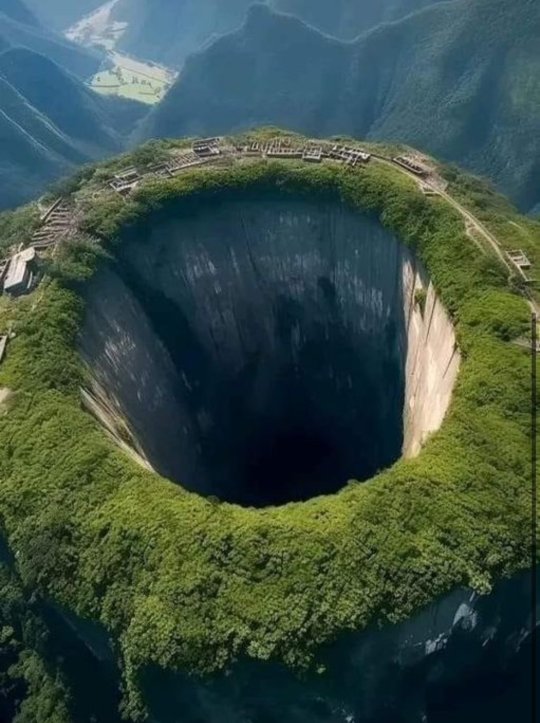
Le puits naturel le plus profond et le plus grand de la planète s'appelle Xiaozhai Tiankeng. Il est situé à Fengjie, dans la municipalité de Chonqinun, au cœur de la Chine. Il est entièrement naturel et atteint une profondeur de 662 mètres, avec une longueur de 626 mètres et une largeur de 537 mètres. Mais ce qui frappe le plus, c'est l’explosion de vie qu’il abrite. Xiaozhai Tiankeng est ce que les géologues appellent un gouffre ou un fossé, une dépression du terrain générée, entre autres facteurs, par l'effet de l'eau. Dans ce cas, il a été formé au sommet d'une grotte et abrite une rivière souterraine mesurant au total 8,5 kilomètres et se jette dans une cascade spectaculaire. Outre sa taille il impressionne par la biodiversité qu'il abrite à l'intérieur. Sa base est si vaste qu'elle abrite près de 1 300 espèces de plantes, des animaux sauvages. Parmi les « locataires » les plus fascinants qui se promènent dans leur forêt souterraine, se distingue la panthère nébuleuse (Neofelis nebulosa), un chat à fourrure incomparable qui atteint 1,1 mètre et se repose généralement dans les arbres. Ce tiankeng s'étend sur une vaste zone karstique de 280 km2 formée de calcaire. Les experts estiment que ce gouffre, d'une profondeur comprise entre 511 et 662 mètres, s'est formé au cours des 128 000 dernières années. Pendant une grande partie de son histoire, jusqu’à l’effondrement du toit de la grotte, c’était une immense grotte souterraine. Il existe également d’autres tiankengs de taille remarquable, comme le Dashiwei, situés à travers la Chine. Curieusement, malgré sa taille, Xiaozhai Tiankeng a commencé ses études relativement récemment, même si la population locale le connaît depuis l'Antiquité
10 notes
·
View notes
Text
LES PRINCIPAUX LIEUX •••

Et aujourd'hui je vous dévoile les lieux de RP de WHAT IF? IMAGINE. Un gros gros merci à angelsway, nouvelle membre du staff en tant que validatrice fiche, qui a rédigé une (très très très) bonne partie des sous-forums qui accompagnent ces lieux, si ce n'est le lieu lui-même !
OAKLEAF HILL •••
Zone historique de Greens River, ce quartier représente le cœur de la ville puisque les grands monuments de celle-ci se regroupent par ici. Quand il y a des festivités, c’est sur la grande place centrale que les habitants aiment se retrouver ou au bar du lac pour les plus riches. D’une certaine façon, tous les chemins mènent à Oakleaf Hill.
TEAKWOOD PLAZA •••
C'est le quartier commerçant. Il doit son nom au bois de teck utilisé dans la construction de nombreux meubles et bateaux. Une partie du bois était d'ailleurs utilisée à l'ancienne scierie désormais à l'abandon. On y retrouve entre autres de quoi s'alimenter et se soigner mais aussi de quoi s'armer. Welcome to the United States of America.
ROSEWOOD PARKWAY •••
Le quartier socioculturel. Ici se retrouvent différents établissements avec un point commun : celui d'encourager la socialisation. Que vous soyez croyant ou non, vous pourrez toujours aller parler avec la communauté religieuse. Sinon, vous pourrez toujours visiter le musée du quartier ou le parc à jeux.
HIGHSIDE TOWN •••
Highside Town est la nouvelle expansion de Greens River, ce qui ne plaît pas à tous, et encore moins aux esprits les plus conservateurs. C’est le quartier le plus moderne, au contraire de Oakleaf Hill. On y retrouve la boîte de nuit, le cinéma, le centre commercial, la banque et même un grand hôpital, pour soigner tous vos maux ! C'est également ici que l'on retrouve l'UGR, soit l'université.
NATIONAL FOREST •••
Une forêt luxuriante avec une belle diversité au niveau de la faune et de la flore. Le garde forestier qui vit sur place essaie de préserver au maximum cet endroit et compte également sur le bon sens des habitants et des visiteurs qui foulent les sentiers de la forêt, viennent y pique-niquer, s’y baigner ou qui arpentent les chemins pour une toute autre raison.
ENVIRONS •••
Dans les alentours des différents quartiers, on retrouve plusieurs lieux tout aussi fréquentés bien qu’ils soient un peu plus excentrés. Il y a aussi bien des lieux de passage pour les touristes que des lieux de divertissement pour les habitants.
#rpg#forumactif#forum rpg#projet forum rpg#city rp#gossip girl#nerve#rpg francophone#french rpg#rpg français#rp stuff#pub rpg#aes#aesthetic#icons aesthetic#icons#avatar 200x320#avatar 400x640#rp#what if? imagine
5 notes
·
View notes
Text

« “Ānanda, tra gli elementi interconnessi che hanno fatto si che la ciotola esista, vedi l’acqua?” “Certo, signore. Il vasaio ha avuto bisogno di acqua per impastare l’argilla e modellare la ciotola”. “Dunque l’esistenza della ciotola dipende dall’esistenza dell’acqua. Inoltre, Ānanda, vedi l’elemento fuoco?” “Certo, signore. E stato necessario il fuoco per cuocere l’argilla, dunque vedo in essa fuoco e calore” “Che altro vedi?” “Vedo aria, senza la quale il fuoco non si sarebbe acceso e il vasaio non avrebbe respirato. Vedo il vasaio e l’abilità delle sue mani. Vedo la sua coscienza. Vedo il forno e la legna che l’ha alimentato. Vedo gli alberi che hanno fornito la legna. Vedo la pioggia, il sole e la terra che hanno fatto crescere gli alberi. Signore, vedo migliaia di elementi interconnessi che hanno concorso alla formazione di questa ciotola”. “Eccellente, Ānanda! Contemplando questa ciotola si vedono in essa gli elementi interdipendenti che le hanno dato origine. Questi elementi, Ànanda, sono all’interno e all’esterno della ciotola. Un elemento è la tua Stessa coscienza. Ànanda, se tu togliessi il calore per restituirlo al sole, se restituissi l’argilla alla terra, l’acqua al fiume, il vasaio ai genitori e la legna alla foresta, esisterebbe ancora la ciotola?” “No, signore. Restituendo alla loro origine gli elementi che hanno concorso alla formazione della ciotola, questa non esisterebbe più” » . www.meditare.net *************************** « “Ānanda, among the interconnected elements that made the bowl exist, do you see water?” “Yes, sir. The potter needed water to knead the clay and shape the bowl.” “So the existence of the bowl depends on the existence of water. Also, Ānanda, do you see the element of fire?” “Yes, sir. Fire was needed to bake the clay, so I see fire and heat in it.” “What else do you see?” “I see air, without which the fire would not have been lit and the potter would not have breathed. I see the potter and the skill of his hands. I see his consciousness. I see the oven and the wood that fed it. I see the trees that provided the wood. I see the rain, the sun and the earth that made the trees grow. Sir, I see thousands of interconnected elements that contributed to the formation of this bowl.” “Excellent, Ānanda! Contemplating this bowl, one sees in it the interdependent elements that gave rise to it. These elements, Ànanda, are inside and outside the bowl. One element is your own consciousness. Ànanda, if you took away the heat to return it to the sun, if you returned the clay to the earth, the water to the river, the potter to the parents and the wood to the forest, would the bowl still exist?” “No, sir. By returning to their origin the elements that contributed to the formation of the bowl, it would no longer exist.” » . www.meditare.net
2 notes
·
View notes
Text

Before: 1937 home in River Forest, IL.

After it was painted white. Sold for $1.85M.



Large great room and dining room all done in knotty pine.


After.
99 notes
·
View notes
Photo

Battista Franco Veneziano (Il Semolei) also known by his correct name of Giovanni Battista Franco, before 1510-1561
The Rape of Deianira, n/d, etching and engraving, 24.6x38.5 cm. Bartsch XVI, 132, 40 I (of II).
Franco’s printed œuvre is stylistically very varied, ranging from works, executed in the controlled and disciplined engraving technique of the Raimondi School, to prints treated with a lighter touch, in which the artist often employs the more spontaneous and expressive medium of etching. This freedom of treatment matches the fluid and nimble linework of his drawings. In the present sheet both techniques are skilfully combined. The basic elements of the composition are first sketched with the etching needle. The burin is then used to add details of bodies, clothing and vegetation, bringing out their linear structure and three-dimensionality. Details of the terrain and vegetation are treated as pure etching, while the lightness and transparency of the hatching reinforce the dynamic impact of the scene. Deianira, who is being abducted by the centaur Nessus, looks as though she has been caught up in a whirlwind and turns away from her ravisher in horror. Hercules aims his bow to punish the forest denizen for his evil deed. In the face of all this violence the river god in the foreground seems almost to recoil fearfully.
Via
6 notes
·
View notes
Text
Blackforestline
Canon EOS R
Sigma 24-105mm F4 DG OS HSM | Art
ƒ/9.0
51.0 mm
1/125
iso 160

Blackforestline suspension bridge
(FR) Pont suspendu dans la Forêt-Noire Le Black Forest Line Pont Suspendu est un pont situé dans la Forêt-Noire, en Allemagne, à proximité du village de Todtnauberg. Il mesure 450 mètres de long et domine le sol de 120 mètres.
Caractéristiques
Longueur : 450 mètres Hauteur : 120 mètres Coût : 5 millions d’euros Ouverture : fin mai 2023 Capacité : 300 personnes simultanées
Emplacement Le pont est situé dans la Forêt-Noire, à proximité du village de Todtnauberg, à environ 1h30 de route de Strasbourg.
Contexte Le Black Forest Line Pont Suspendu est l’un des derniers ajouts à la région touristique de la Forêt-Noire. Il est conçu pour offrir une expérience unique aux visiteurs, avec un panorama spectaculaire sur la vallée et les chutes de la rivière Stübenbach.
Comparaison avec d’autres ponts suspendus Le Black Forest Line Pont Suspendu est plus long et plus haut que le Wildline Pont Suspendu, situé à Bad Wildbad, dans le nord de la Forêt-Noire. Cependant, il est plus court que le pont suspendu de Rottweil, qui est en cours de construction.
Impact local L’ouverture du pont suspendu a suscité des débats locaux quant à son impact sur l’environnement et la communauté. Certains résidents sont préoccupés par l’impact touristique et la perturbation de la vie quotidienne, tandis que d’autres voient l’opportunité de développer le tourisme durable dans la région.
En résumé, le Black Forest Line Pont Suspendu est un projet touristique majeur dans la Forêt-Noire, offrant une expérience unique et spectaculaire aux visiteurs.
(EN) Suspension Bridge in the Black Forest The Black Forest Line Suspension Bridge is a bridge located in the Black Forest, Germany, near the village of Todtnauberg. It is 450 meters long and towers 120 meters above the ground.
Features Length: 450 meters Height: 120 meters Cost: 5 million euros Opening: end of May 2023 Capacity: 300 people simultaneously
Location The bridge is located in the Black Forest, near the village of Todtnauberg, about 1.5 hours drive from Strasbourg.
Background The Black Forest Line Suspension Bridge is one of the latest additions to the Black Forest tourist region. It is designed to offer a unique experience to visitors, with a spectacular panorama of the valley and the waterfalls of the Stübenbach River.
Comparison with other suspension bridges The Black Forest Line Suspension Bridge is longer and higher than the Wildline Suspension Bridge, located in Bad Wildbad in the northern Black Forest. However, it is shorter than the Rottweil Suspension Bridge, which is currently under construction.
Local impact The opening of the suspension bridge has sparked local debates about its impact on the environment and the community. Some residents are concerned about the tourism impact and disruption to daily life, while others see the opportunity to develop sustainable tourism in the region.
In summary, the Black Forest Line Suspension Bridge is a major tourism project in the Black Forest, offering a unique and spectacular experience for visitors.
#Allemagne#SIGMA 24-105MM F/4 DG OS HSM ART#Lieux#Road-Trip#Alsace#Germany#Canon EOS R#24-105MM F/4 DG OS HSM#flickr#outdoor#photographers on tumblr#original photographers#extérieur#Blackforestline#black forest#schwarzwald
12 notes
·
View notes
Photo

Julie Surprenant was a happy ang outgoing 16-year-old girl from Terrebonne, Quebec, which is just north of Montreal. In 1999, she was living with her father, Michael, who had separated from her mother, and was working part time as a gift wrappers at a store in the Galleries Terrebonne shopping centre.
On the evening of 15 November, 1999, Julie told her father she was going to the youth community centre after school. She left with a friend at around 8:30PM that night. They caught a bus, and Julie’s friends departed close to her home, with Julie continuing the rest of the bus journey alone.
The bus pulled up alongside Julie’s stop, which was just metres away from her home. Here, the driver observed a lone male standing at the bus stop. He asked whether he was boarding the bus, but he said that he wasn’t. From here, what happened to Julie remains a mystery even today.
Julie never arrived home that night, and her worried father reported her missing. Missing person posters provided a description of Julie along with the clothing she was last wearing: a floral skirt with a blue petticoat, navy blue socks over black tights, a blue scarf with a fish patter, a green wool jacket and a dark brown leather coat.
The community came out in droves to help search for Julie, and they searched far and wide for any trace of Julie. One week into the search, they came across a body hanging from a necktie in a forest. However, the body was identified as a local man who had been missing for several days.
The search continued, with masses of people fanning out into the surrounding woodland, making sure to check any abandoned buildings. With each day that passed, Julie’s family became more and more concerned for her welfare; she wasn’t the type of teenager to run away, leading them to believe something nefarious had happened.
Investigators quickly zoned in on Richard Bouillon, a convicted sex predator that lived just a stone’s throw away from Julie. He was brought in for questioning and staunchly denied the accusations. With no evidence for charges to be filed, eventually the case went cold.
In 2001, however, Bouillon claimed to a journalist that his roommate had killed Julie. He was later convicted in a different case of rape, molestation, sexual assault and drug-trafficking. Bouillon passed away on 22 June, 2006, at Laval’s Cite de la Sante Hospital while serving his six-and-a-half year sentence.
In January of 2011, there was a massive breakthrough in the case when it was reported that Bouillon had made a death-bed confession to Julie’s murder. He said that he stuffed Julie’s body into a sports bag and dumped it into the Mille-Iles River in front of a church not too far away from her home.
The medical worker he had confessed to waiting almost five years before coming public with the information. Julie’s father, Michael, commented: “I was in shock when I heard the news this week because I wasn’t expecting it and because there’s a level of credibility to it.”
The following year, a coroner’s report found that Bouillon had most likely killed Julie, but since he was deceased, he was never able to be charged.
34 notes
·
View notes
Video
tumblr
8 MARZO - FESTA DELLA DONNA
È donna, tutto quello che al seme dona la vita. E’ donna tutto quello che la vita protegge, che la conserva, la nutre, l’esalta, la difende, la libera, l’abbellisce, la sostiene, l’ama, la canta, la danza, dona al nulla una voce, al buio una luce, al gelo una carezza, al silenzio un verso. Così è donna il mare, è donna il cielo, la terra, il fuoco, il vento, la pioggia, le stagioni, il sole, la luna, la tenerezza, la fedeltà, il sorriso, il pianto, il bosco, il fiume, i fiori ed i loro colori. È maschio solo il seme che la terra nutre, la goccia che il mare raccoglie, la foglia che l’albero nutre e il vuoto che il vento riempie, la rabbia spenta dall’amore, la pagina che la penna riempie, la corda che la chitarra trasforma in suono perché nulla brilla da solo, nessuno risplende di una sua luce se qualchedun altro non lo illumina, nessun seme ha senso se non trova terra per accoglierlo, acqua per nutrirlo, sole per farlo crescere. Per questo l’uomo è solo un seme e le donne sono acqua, sono terra e sole, sono il mondo e il cielo, il sogno e il domani.
Is a woman, everything that gives life to the seed. Everything that life protects, that preserves, nourishes, exalts, defends, frees, embellishes, supports, loves, sings, dances, gives a voice to the void, is woman. the light in the dark, in the frost a caress, in silence a verse. Thus the sea is a woman, the sky, the earth, the fire, the wind, the rain, the seasons, the sun, the moon, tenderness, fidelity, the smile, the tears, the forest, the river, are a woman, flowers and their colors. Is a male only the seed that the earth nourishes, the drop that the sea collects, the leaf that the tree nourishes and the void that the wind fills, anger quenched by love, the page that the pen fills, the rope that the guitar transforms into sound because nothing shines by itself, no one shines with its own light if someone else doesn't illuminate him, no seed makes sense if it doesn't find earth to welcome it, water to feed it, sun to make it grow. For this reason man is only a seed and women are water, they are earth and sun, they are the world and the sky, dreams and tomorrow.
17 notes
·
View notes